These Old-Fashioned Cherry Scones are prepared with every-day pantry ingredients and do not require any dairy or eggs for a beautiful rise. Cherry scones are sweet, light, crumbly, and just delicious filled with fruit jam and whipped cream. Perfect for a Cream Tea, Devonshire Tea, High Tea, Supper-Time, Tea-Time, or Afternoon Tea or just for a quick tasty snack. These scones use vanilla as a flavouring but almond extract or essence could be used instead for a delicious Cherry Bakewell Scone.

These Old Fashioned Cherry Scones are prepared with everyday pantry ingredients and are dairy and egg-free. However, you don't have to be vegan to enjoy these tasty scones as they taste exactly like traditional cherry scones - also you can use whatever milk and baking fat you normally use.
Our family enjoys these scones filled with fruit jam and whipped cream which we prepare with Elmlea Double Plant Cream. This dairy-free cream whips quickly into the most amazing light but thick cream.
Jump to:
Origin of cherry scones
Cherry scones, like other scones, are traditional to Scottish cookery. The word "scone" itself is claimed to have come from the Gaelic word 'sgonn' meaning a shapeless mass or large mouthful. Another theory suggests the name might come from the Dutch word 'schoonbrood', meaning fine bread, or from the German word 'sconbrot', which also translates to fine bread.
Scones dates back to at least the 16th century and evolved from the Scottish bannock which was a type of large, thick flatbread that was originally made with oatmeal, barley, or beremeal. Beremeal is an Ancient type of barley that was brought over by the Vikings and so is more popular in the Shetland Islands.
These meals or flours were good hardy ones as the grains flourished in the Scottish climate making them more popular than wheat which required a warmer climate and better soil, and it wasn't until the 18th-19th century that wheat became more popular due to agricultural advances.
Before the farming advances, the bannock was the main type of bread in Scotland. The barley grains were usually ground just before baking, by housewives using a rudimentary millstone called a quern which consisted of two stones. In some Scottish rural areas such as the Highlands and Islands, the quern was still being used into the 19th Century. Next, the bannocks were cooked on a flat griddle at the fireside before being wrapped in a cloth.
The modern scone likely evolved from the traditional bannock sometime during the 19th century, coinciding with the invention of baking powder. Baking powder was a god-send to many home cooks as it drastically reduced preparation and baking times - as opposed to using yeast or harnessing wild yeast from the air!
Also, during this period, wheat flour became more readily available in Scotland and began to replace the older, traditional flours. This shift resulted in a scone that bore similarities to the older bannocks, but resembled our modern scones.
For more traditional scone recipes made vegan try our Buttermilk Scones, Cheese Scones, Edinburgh Fruit Scones, and Treacle Scones. As we're a Scottish family we absolutely love scones so will be adding many more recipes.
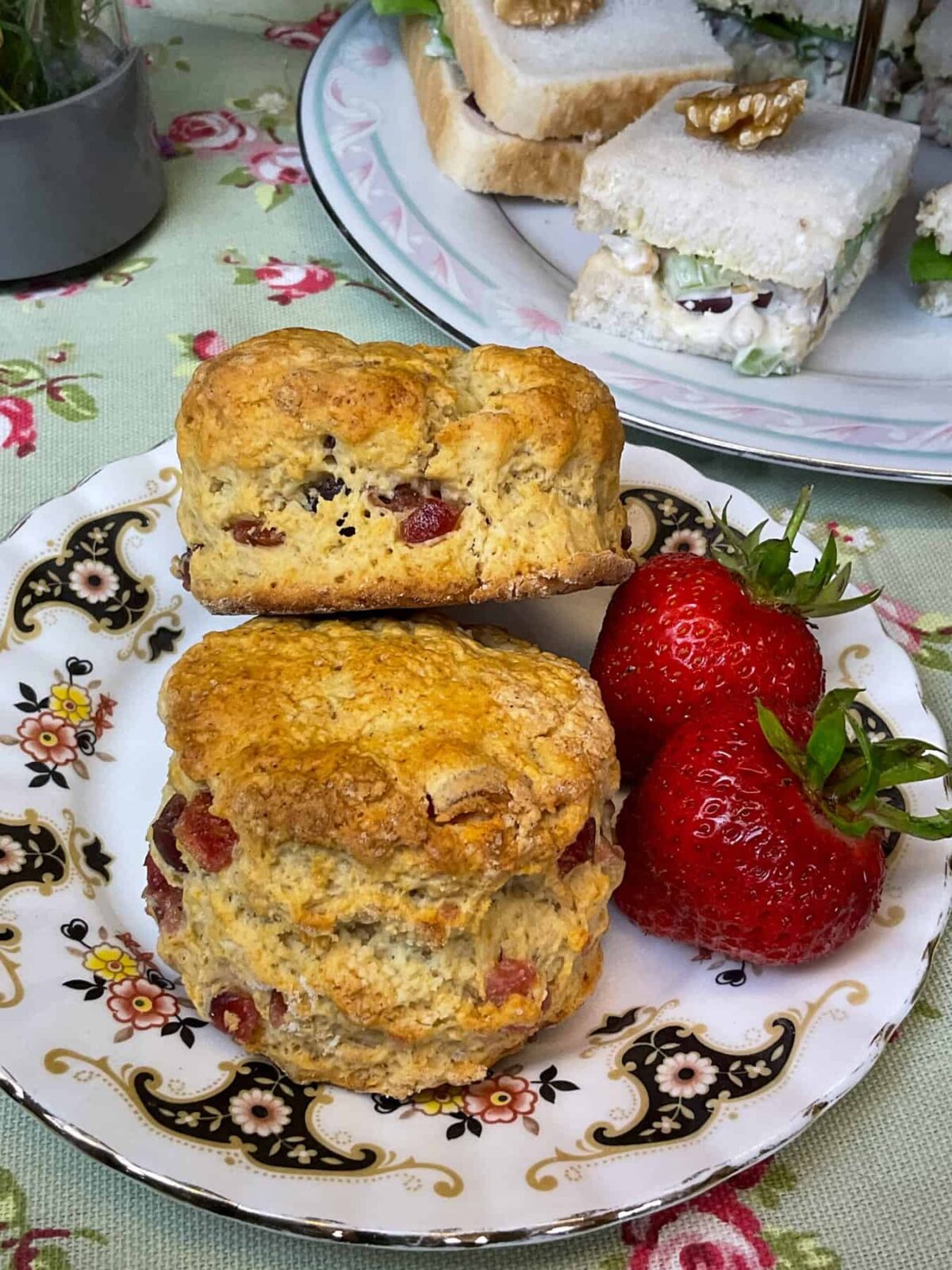
Origin of candied or glacé cherries
Candied cherries, also known as glacé cherries, were first developed during the 14th century. The sweet and sticky cherries, are made by soaking fresh cherries in a sugar syrup solution until they absorb the sugar, becoming sweet and preserving their shape and texture for a long time.
The use of candied fruit became more widespread in Europe during the 16th century, especially in Italy and France. However, it is difficult to pinpoint exactly when glacé or candied cherries were first made in Britain. But it is likely that the candied cherries were brought to the country during or after the medieval period and became more common in the subsequent centuries, as sugar became more readily available.
The use of candied cherries in bakes such as scones, cakes, quick breads and buns became particularly popular in Britain during the 19th Century Victorian era when the custom of taking afternoon tea also began for the upper classes.
More dairy and egg-free glacé cherry recipes
For more vegan glacé cherry recipes do try our delicious Sweet Cherry Loaf Bread, these Irish Classic Fifteens [refrigerator bake], and this amazingly rich Cherry, Cranberry, and Chocolate No-Bake Fridge Cake and this classic Scottish Border Tart. All perfect for a tasty vegan afternoon tea or just for a sweet treat.

Love the flavour of Cherry Bakewell? It's easy to prepare these cherry scones into The Best Cherry Bakewell Scones by simply switching out the vanilla for almond extract or essence, and topping the scones with a few flaked almonds and half a glacé cherry. So delicious especially warm from the oven!
How to prepare
These old-fashioned cherry scones are pretty easy to prepare and quick to bake as they only need about 13-14 minutes in the oven. A scone can be a great alternative to a slice of cake as they have less fat and sugar yet are sweet enough to satisfy a sweet tooth.
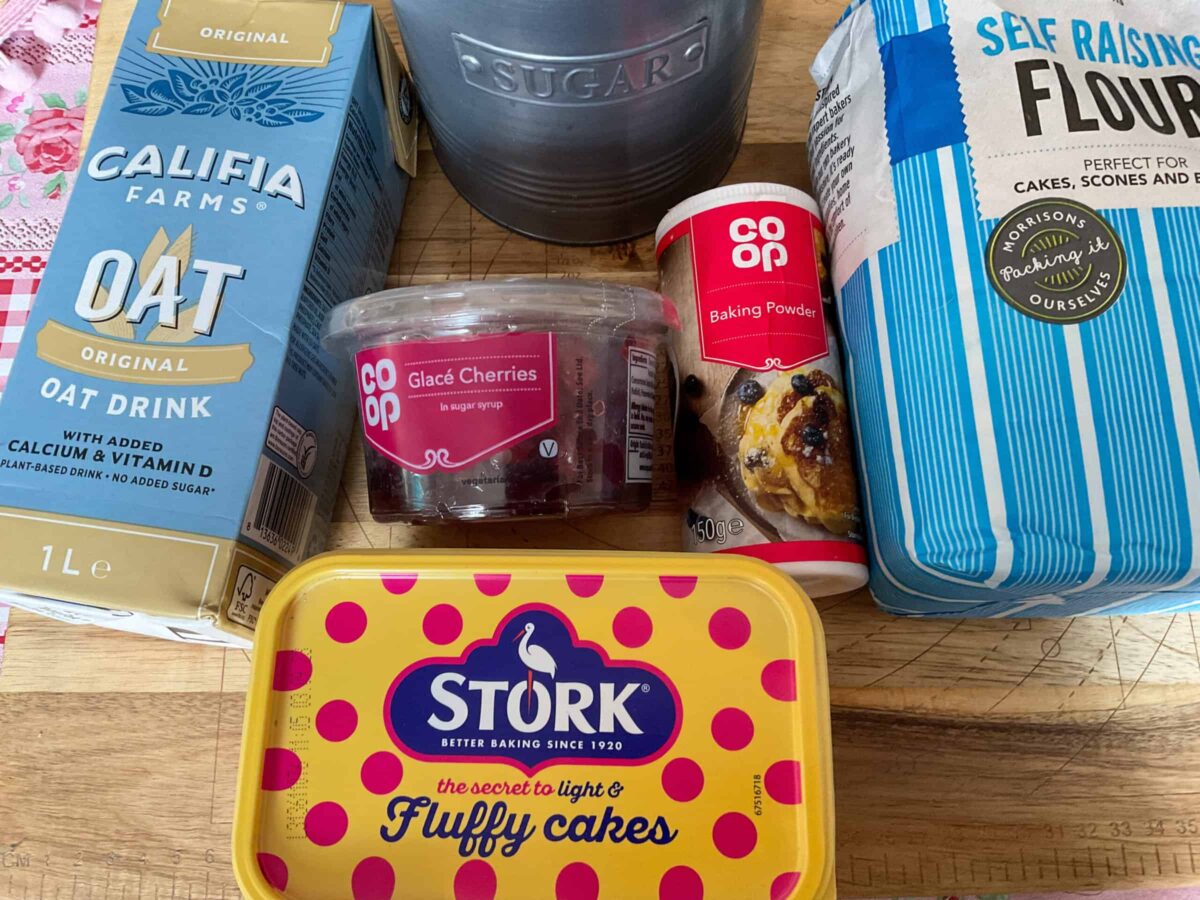
Step 1: First, collect all your ingredients together - milk, margarine, self-raising flour, baking powder, granulated sugar, and glacé cherries.
You can use whatever milk or baking fat that you normally use for this recipe - we like to use oat milk and Stork baking spread.
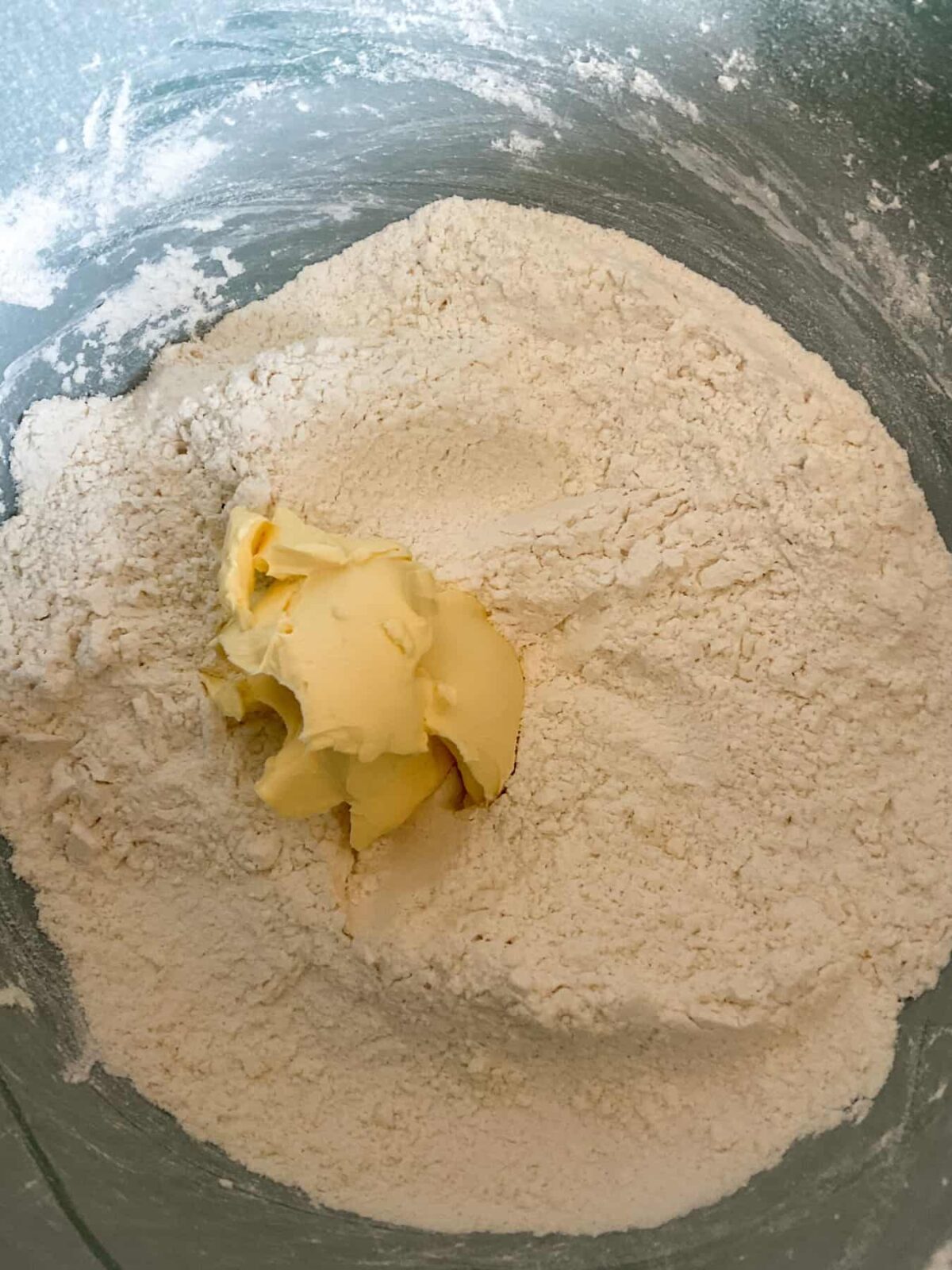
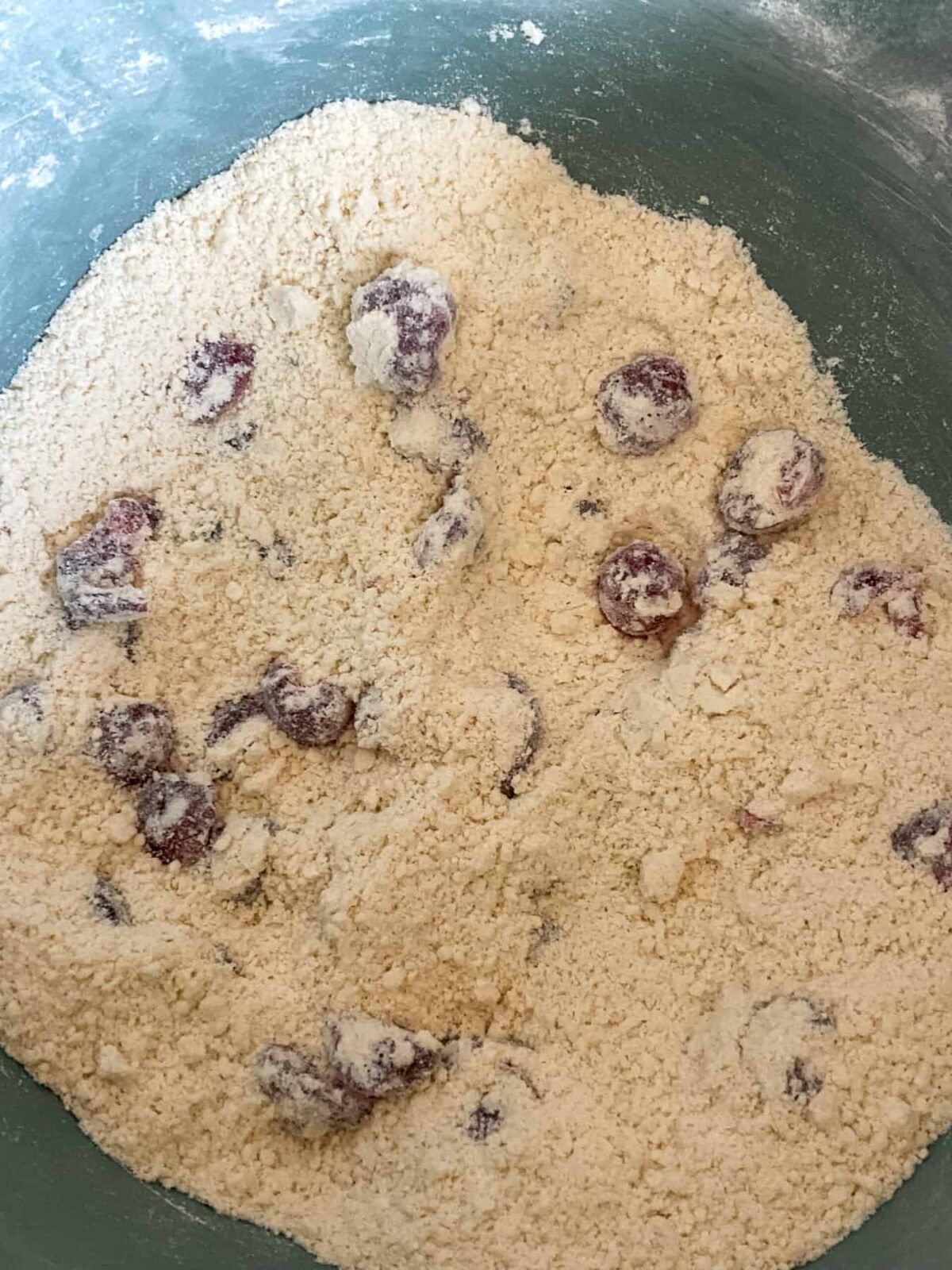
Step 2: Sift the self-raising flour and baking powder into a mixing bowl and stir through the granulated sugar.
Step 3: Drop the margarine into the mixture and using your finger tips rub it into the dry mixture until it resembles fine breadcrumbs.
Step 4: Chop the cherries into halves and quarters and stir through the mixture.
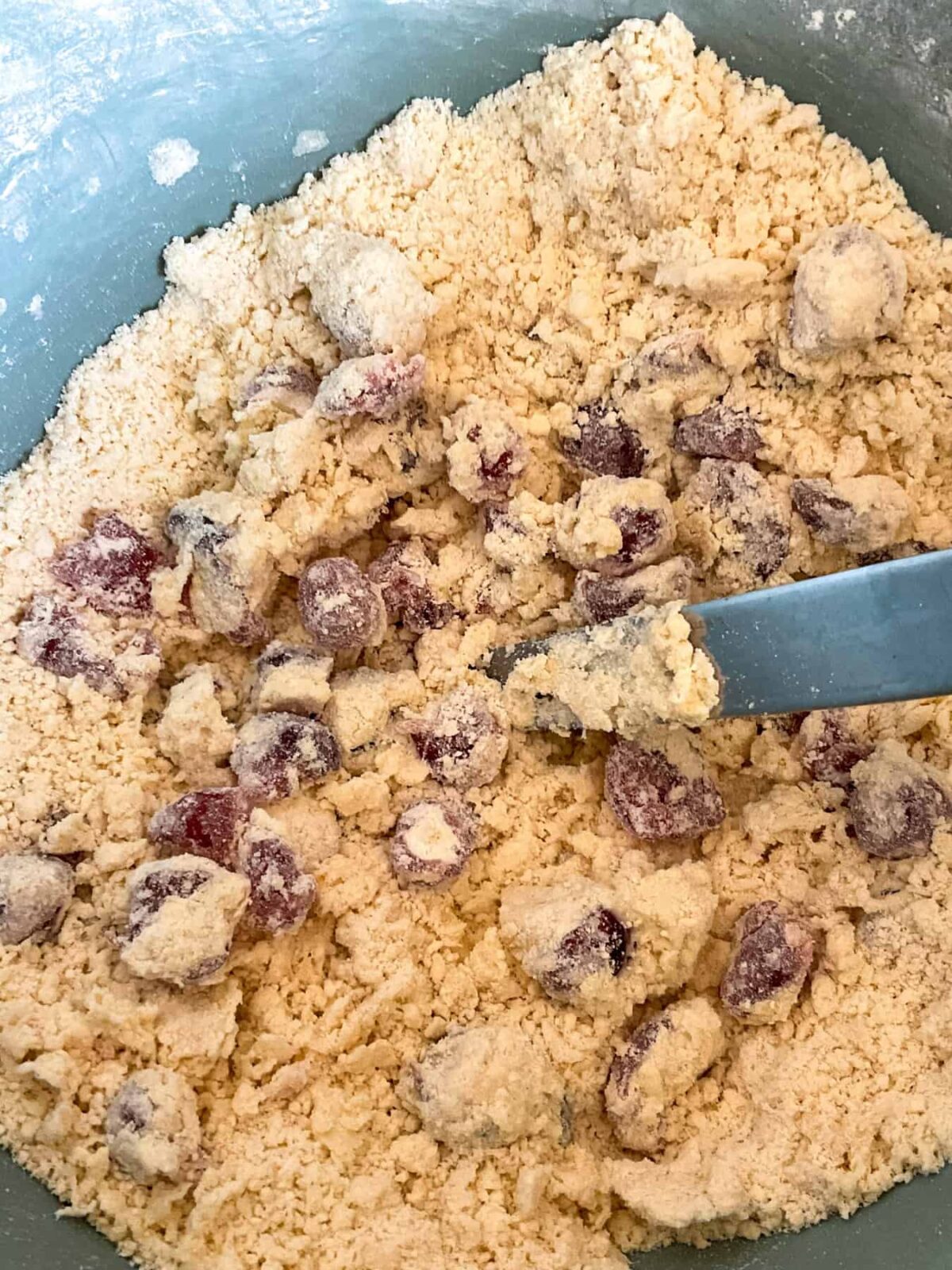
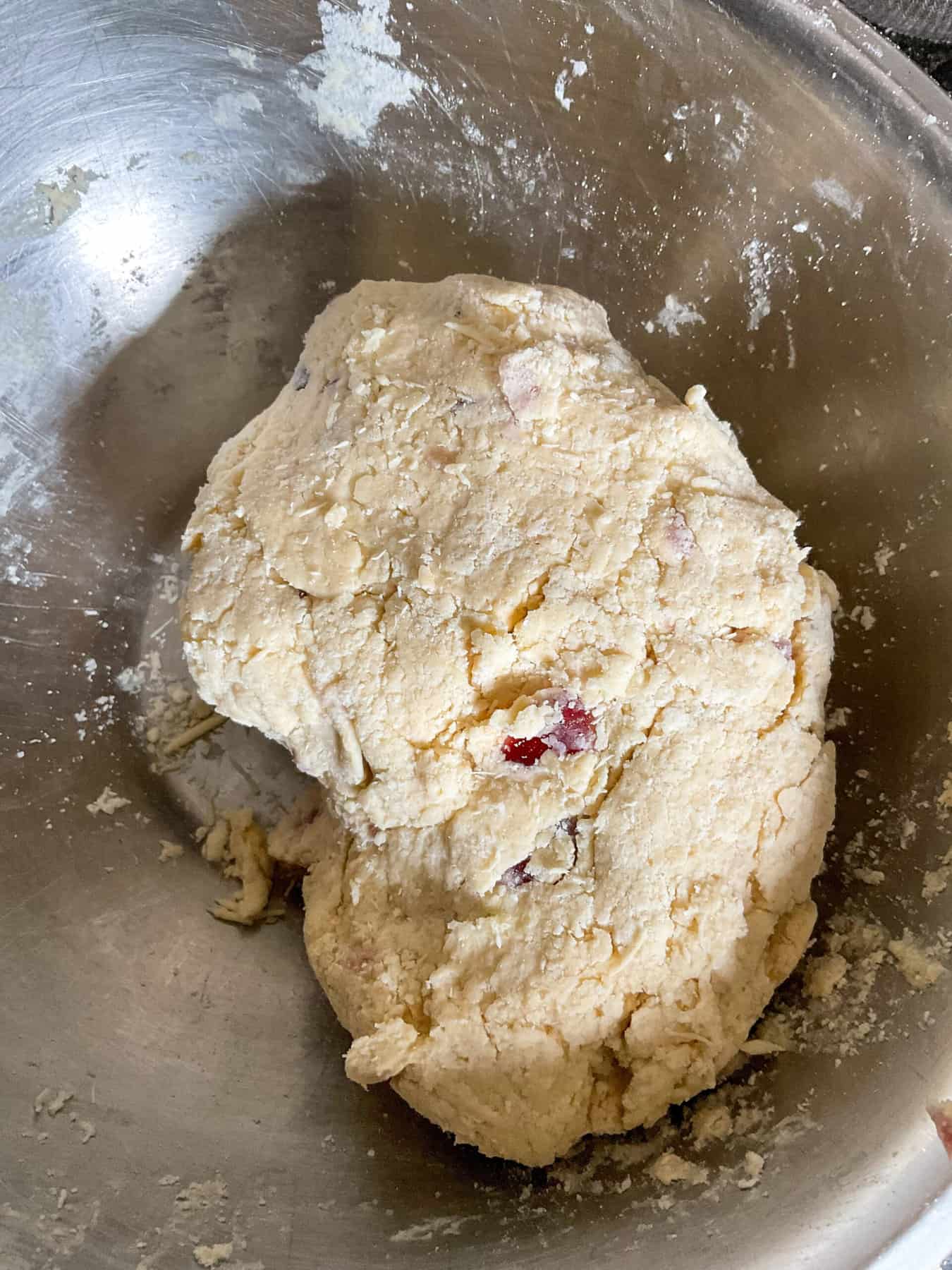
Step 5: Add the vanilla, and stir through enough milk to bring the mixture together into a dough. [Alternatively, instead of vanilla use almond extract for a cherry Bakewell scone.]
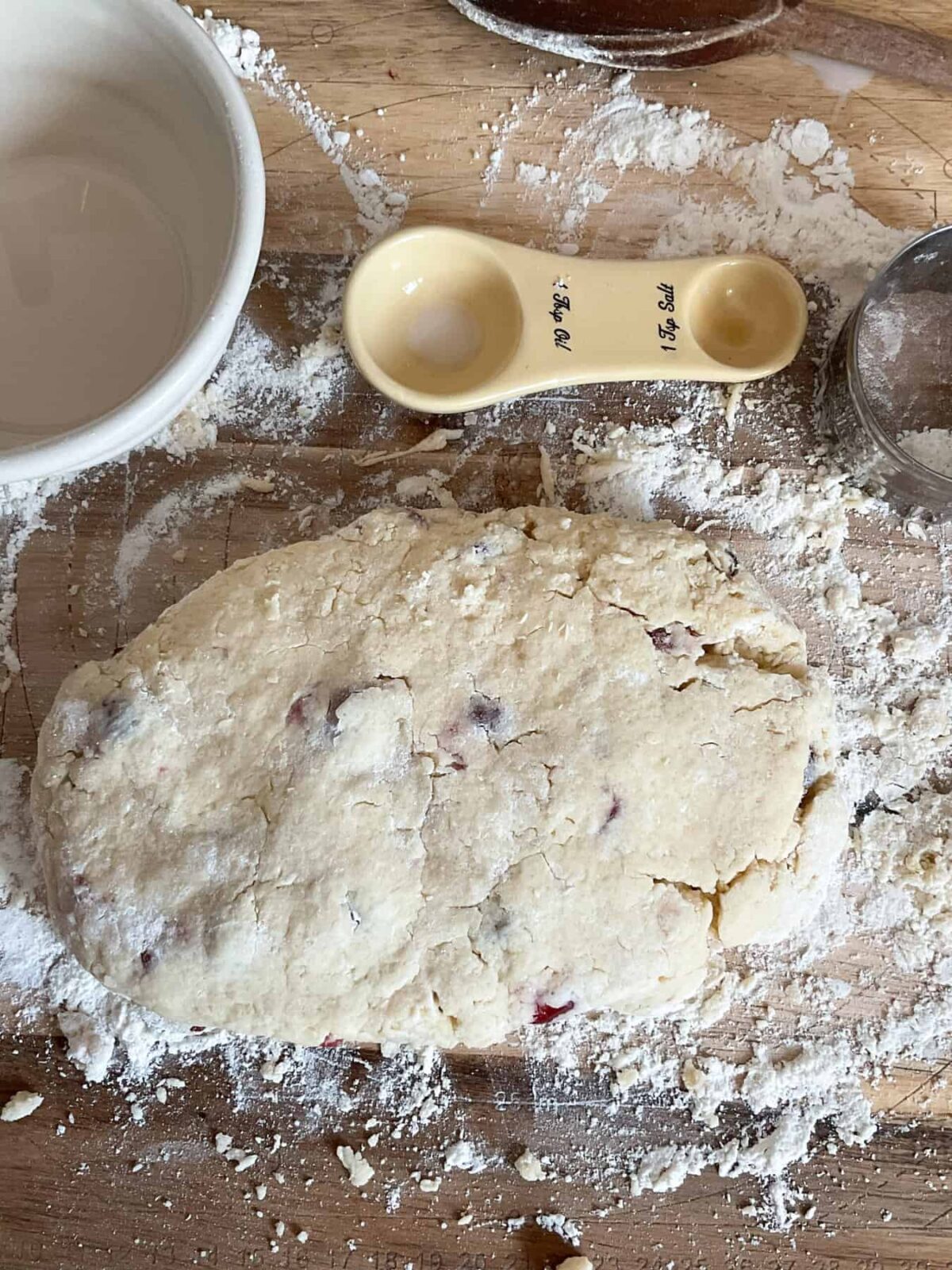

Step 6: Knead the scone dough very lightly just to bring it all together, and place it onto a floured board.
Step 7: Using your hands pat the dough down gently to about ¾ inch thick.
Step 8: Dust the biscuit cutter with some flour and gently stamp out 6 scone rounds.
You won't manage all 6 scones at the one go as the dough will need to be pushed back together and then patted down again.
You may end up with a small amount of dough leftover, and if so this can be formed into a smaller scone and baked along with the other scones as a bakers tester scone.
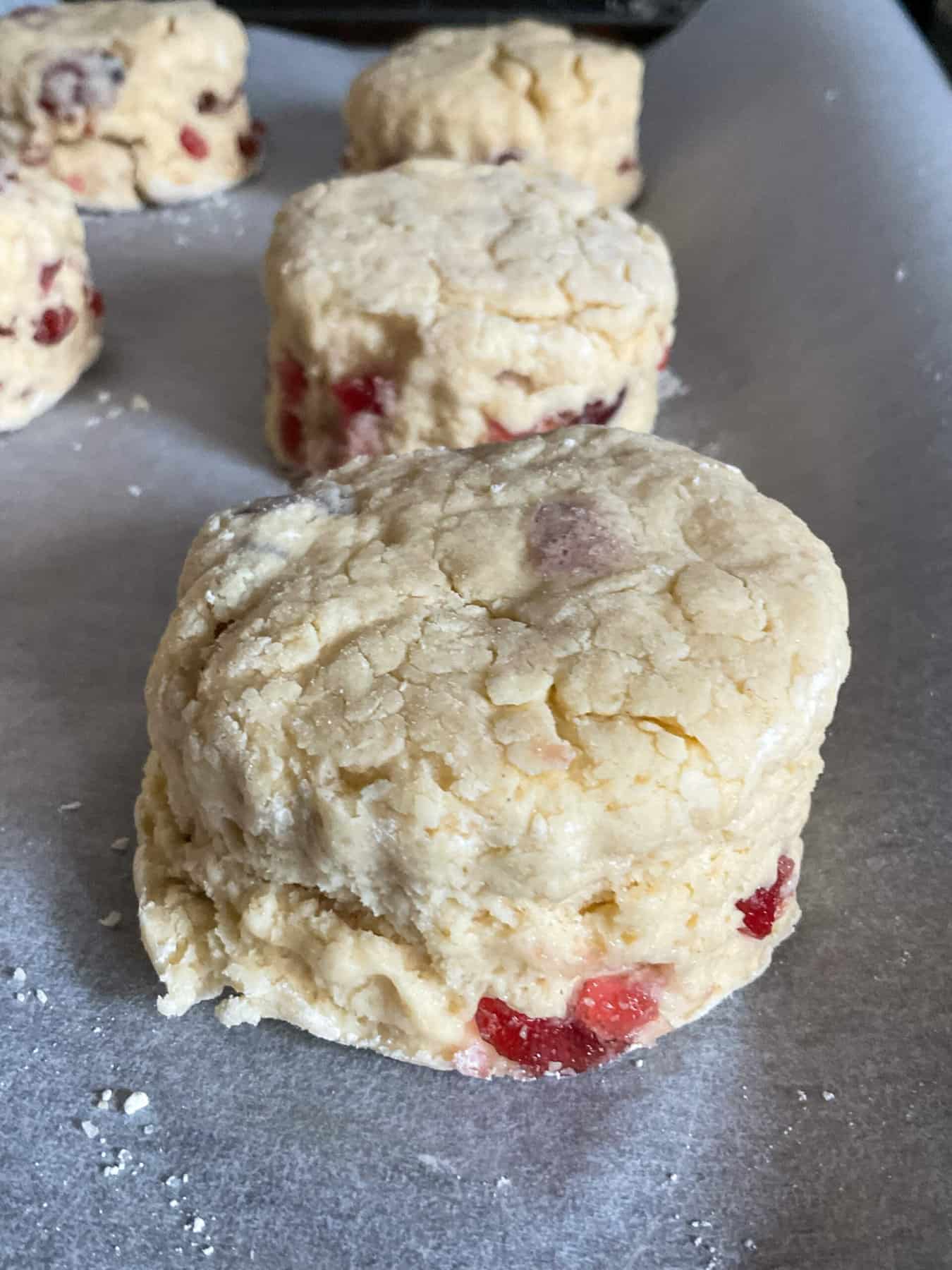
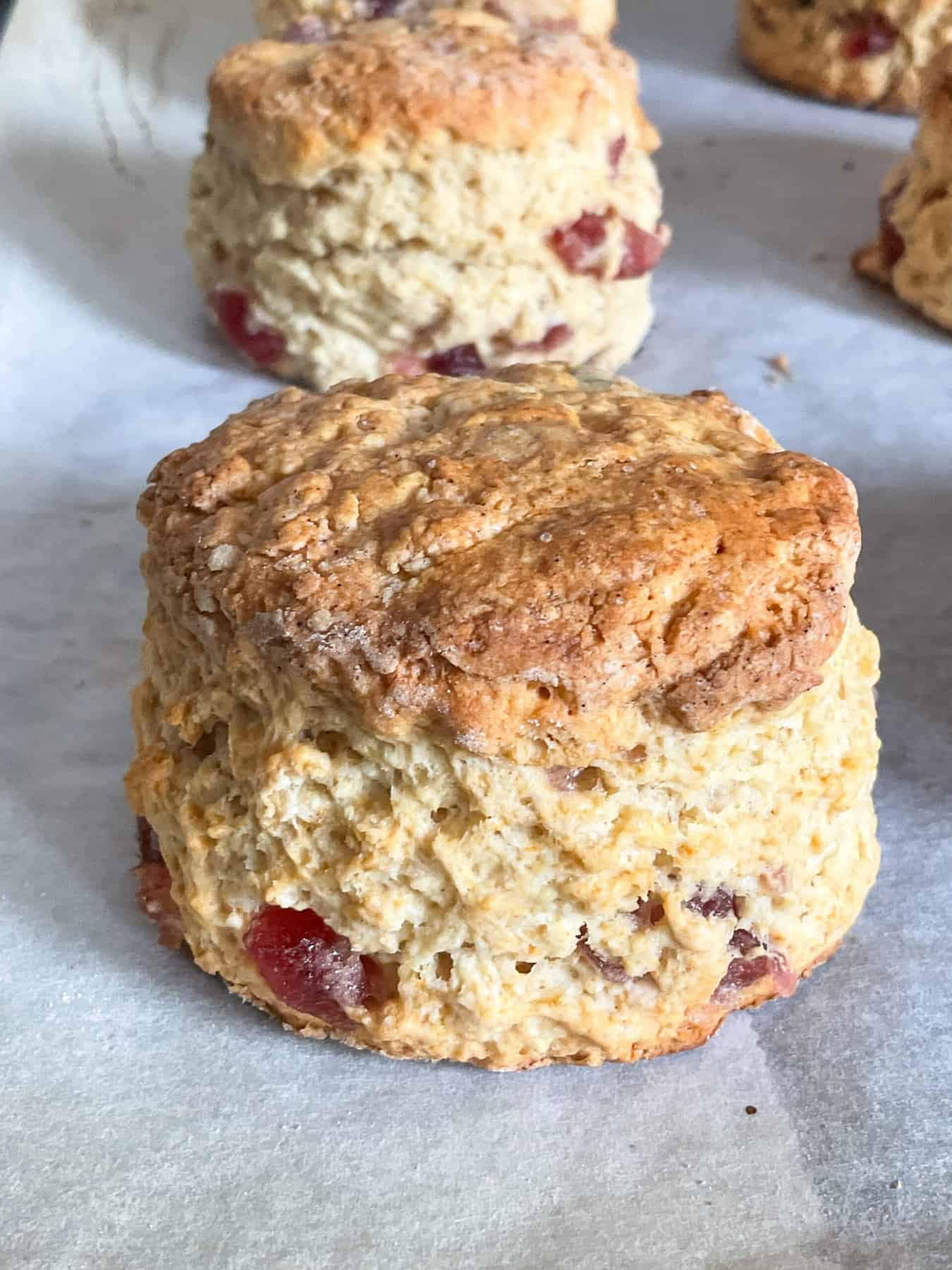
Step 9: Place the scones onto a baking tray and brush the tops with the milk that is left over. Bake for 13-14 minutes until firm, risen, and golden on top.
*See the recipe notes and FAQ section below for more tips on how to check if your scones are baked properly.*

Step 10: Place the scones on a wire rack to cool.
Scones can be enjoyed simply split open and spread with vegan butter or margarine, or your preferred spread, along with a few dollops of fruit jam.
Or add some marmalade, vegan lemon curd, mashed banana, peanut butter, sunflower seed butter, vegan chocolate spread, vegan whipped cream, anything you like really.
Recipe notes
Storing scones
The best way to store scones are to place them into a sealed container, once they are fully cooled down, and store them at room temperature for a few days. Scones are at their best 1-2 days after baking, but are usually fine to eat on the third and fourth day. Scones can also be stored within a food bag or bread bag. Older scones can be refreshed by placing them in a hot oven for a few minutes to warm through.
Freezing scones
Scones can also be frozen, well wrapped with food wrap, for 2-3 months. When you would like one of the frozen scones, thaw them at room temperature or heat them directly from the freezer in a warm oven. Remove any food wrap before thawing and refreshing.
Can I freeze unbaked scone dough?
Yes, you can freeze scone dough to bake at a later date. After cutting the scones, place them on a baking sheet and freeze until solid. Then, transfer them to a freezer bag or container and freeze for 2-3 months. When you're ready to bake, place them on a baking sheet and bake from frozen, adding a few extra minutes to the usual baking time.
FAQ'S
Yes, a toasted scone is very tasty and easy to prepare. Toasting can bring out a slightly different flavour and add crunchy golden edges. Spread with some vegan butter or margarine, or your favourite condiment, its a delicious quick snack.
To toast a scone:
1. Slice the scone in half horizontally, just as you might do with a bagel or muffin.
2. Toast the scone in a toaster if the halves are thin and stable [i.e. not too crumbly] enough, or use an oven or toaster oven. If using an oven, set it to broil or grill, and place the scone halves cut-side-up on a baking sheet. Watch them closely and remove when they start to become golden brown, likely after a few minutes. The scones can have either just the insides toasted or flipped over and the outside toasted as well.
3. A panini machine or an electric hot-plate can also be used to toast the scones.
4. After toasting, you can add spreads, jam, marmalade, or other toppings as desired.
Fresh scones are soft and moist enough to be enjoyed without toasting, but after a few days older scones are very tasty toasted.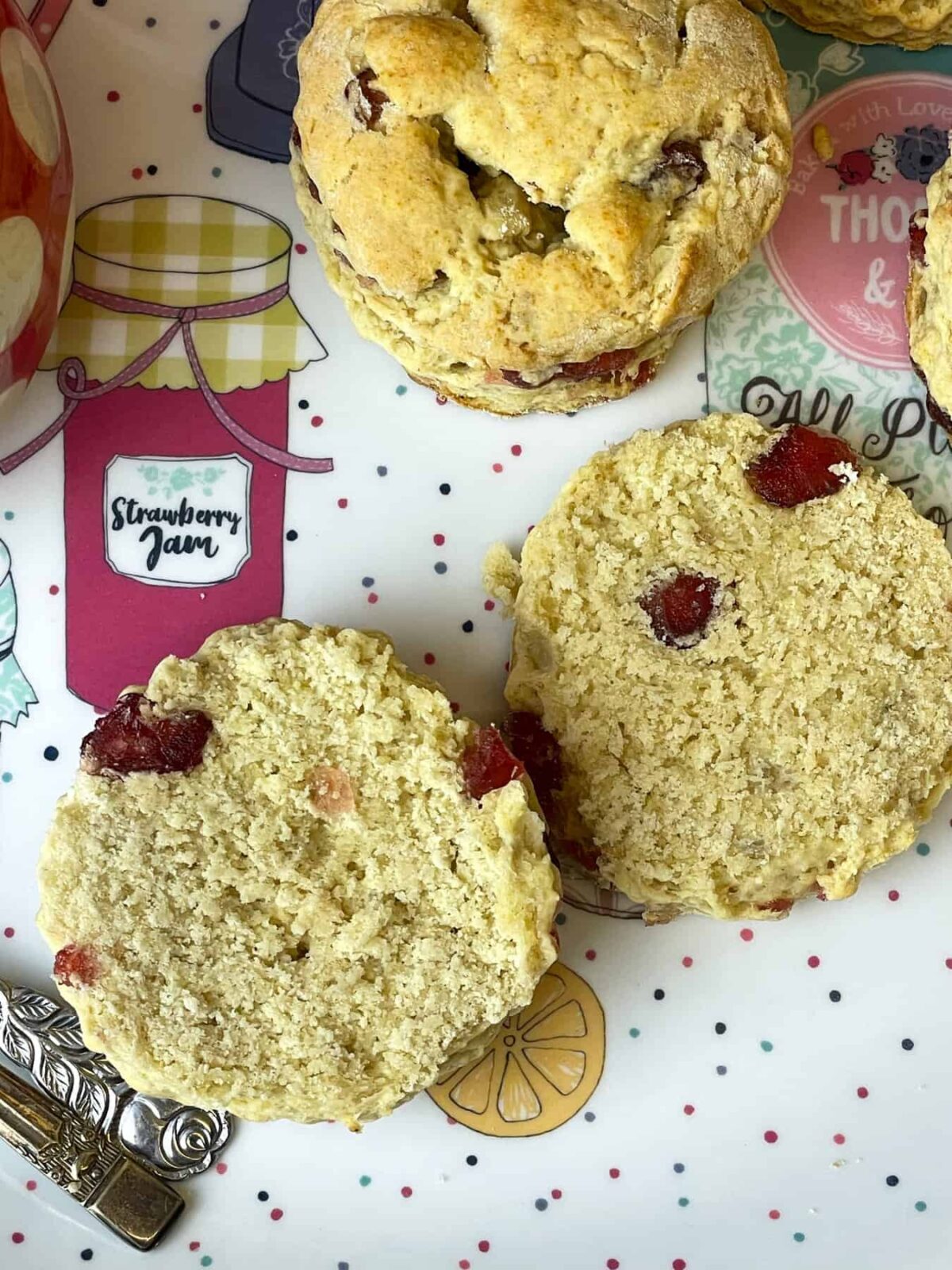
The order of cream and jam on a scone is a topic of much debate in the UK, with two main schools of thought typically associated with two different English regions- Cornwall and Devon.
The "Cornish" method spreads the jam onto the scone first, which is then followed by a dollop of cream. Those who follow this method argue that the jam creates a base that helps the cream stay in place.
However, the "Devonshire" or "Devon" method spreads a layer of clotted cream onto the scone first, before applying a spoonful of jam on top. Fans of this method believe the cream acts much like butter on bread, with the jam as the topping.
Both ways are authentic and whether you opt for the Cornish method or the Devon method often comes down to personal preference or where you were brought up!
A cream tea is a traditional British custom that is especially popular in the southwest of England, particularly in the counties of Devon and Cornwall. It's often served in the afternoon and is a simple, fun meal.
A classic cream tea consists of scones, jam, clotted cream or whipped cream, and a pot of tea. The scones are split open, spread with jam and topped with a dollop of clotted cream (or vice versa), and served alongside the tea.
Cream teas are traditionally served in teahouses, cafes, hotel restaurants, and are especially popular in tourist hot-spots in the UK. It is often enjoyed as part of an afternoon tea at home, a slightly more elaborate meal that might also include sandwiches, a selection of cakes and other sweet or savoury nibbles.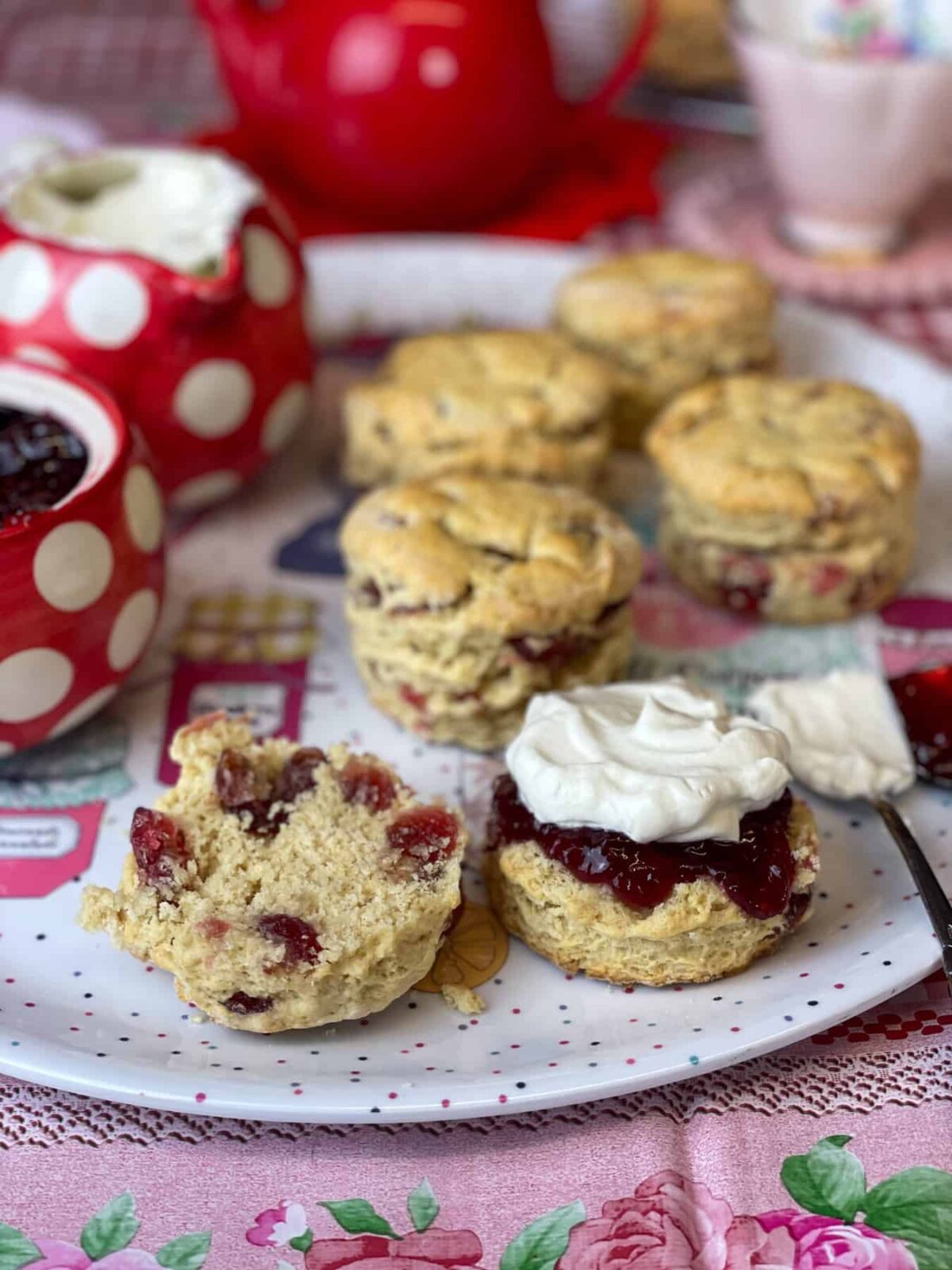
Afternoon tea is a British tradition that started in the early 19th century and it typically consists of a variety of small, dainty, bite-sized foods served with a pot of tea.
The tradition is attributed to Anna, the Duchess of Bedford, who in the 1840s, started inviting friends to join her for an additional afternoon meal to fill the gap between lunch and dinner, which was served later in the evening. The trend quickly caught on among other socialites.
Afternoon tea typically includes the following: a big pot of tea prepared with black tea, green tea, oolong tea, Darjeeling, Earl Grey, or English Breakfast, or just standard popular teas such as Tetley Tea, Yorkshire Tea, or Scottish Blend. Sandwiches sliced into dainty squares, triangles, or fingers are a popular addition, as are a variety of scones, cakes, buns, fairy cakes or cupcakes, etc. Savoury nibbles can include sausage rolls, and little flans or quiches.
The presentation is also a key part of the experience as afternoon tea as often it is served on a tiered cake stand, with the sandwiches on the bottom tier, the scones on the middle tier, and the pastries and cakes on the top tier. Although, many display the food differently.
Over time, afternoon tea has become a beloved British custom, enjoyed at home, in hotel restaurants, tea and coffee shops, as well as ready-made afternoon tea baskets. There are also many themed or special occasion afternoon teas, such as for Christmas, Mother's Day, Easter, or celebrations such as birthdays.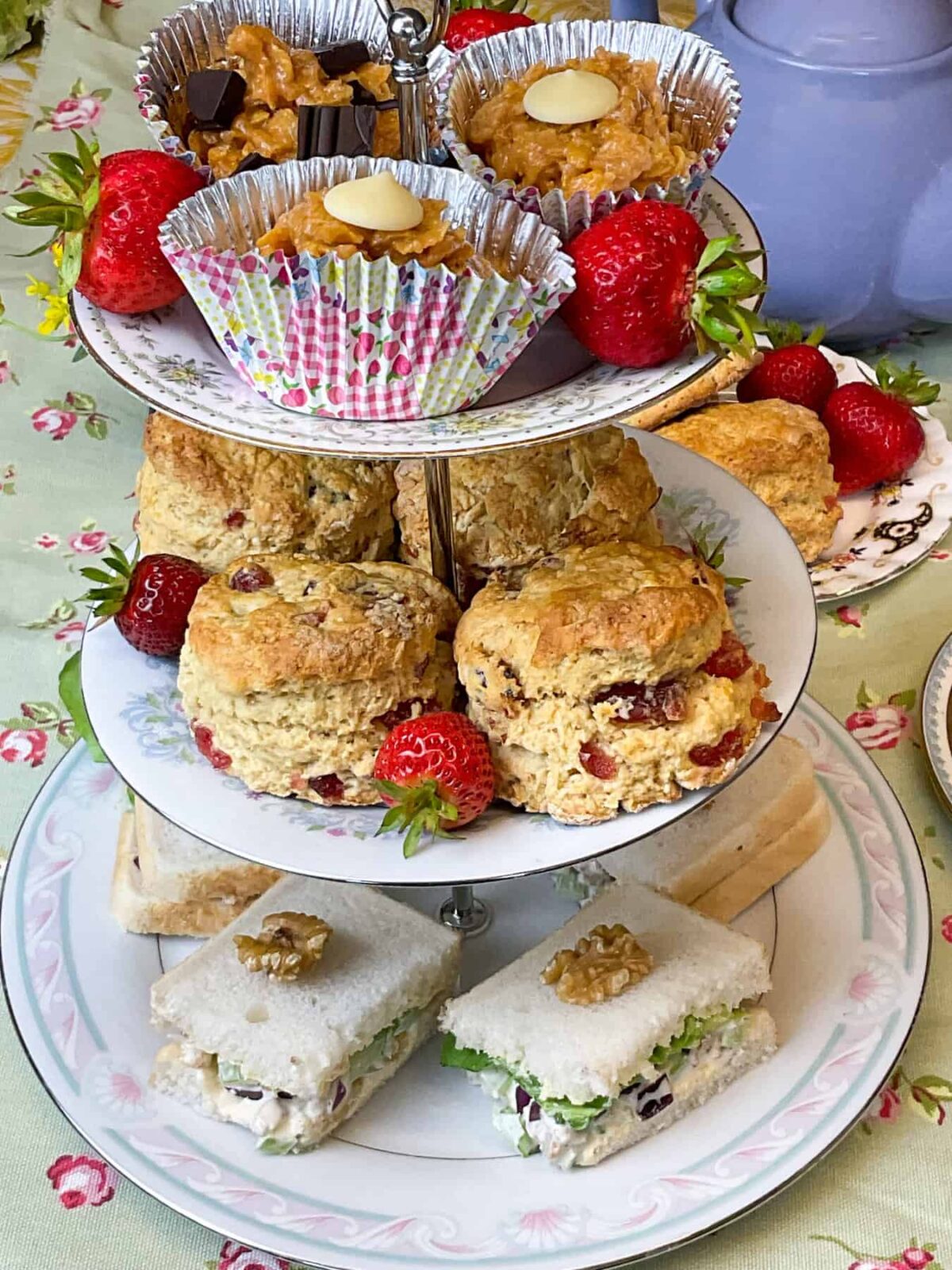
High tea, contrary to what the name might suggest to those unfamiliar with the term, is not a fancier version of an afternoon tea. Instead, high tea originated among the British working class, during the 19th century, and was a filling meal that was typically served when workers returned home at the end of the day, around 6 p.m.
It was essentially a dinner or main meal and was considered an early meal as it was served around 5 or 6 o'clock whereas the richer folk [being full from their afternoon tea leisure's!] would be dining later around 7.30-9pm and this could extend very late into the evening.
Traditional working class high tea would include hearty, savoury dishes such as meat pies, fish, seafood, beans, peas, cheese, potatoes, vegetables such as cabbage and swede, salted meat, bread and butter, pickles, and if available sweet home-baking such as scones, cakes, biscuits, tarts or pies. It would, of course, also include many cups of tea.
Over time and especially outside of the UK, the term "high tea" has often been used to describe fancy versions of an afternoon tea, possibly due to the assumption that "high" sounds more elite or formal.
However, in its origins and traditional usage, high tea and afternoon tea referred to very different meals with a high tea being a filling meal for the working class, and the latter being a light afternoon meal for the upper classes and those well-off folk who had more time during the day for a long break.
In modern times, some parts of Britain refer to the main dinner as tea-time and this may hark back to the times when it was known as a high-tea.
I grew up in lowlands Scotland during the 80s and 90s, and we used the terms dinner-time to refer to what is regarded as 'lunch-time', served around 12-1pm, and our main meal at 5-6 o'clock was called tea-time. Also we didn't have a pudding straight after dinner as we waited until around 8pm to have supper-time which could be a pudding such as apple pie, or a bowl of breakfast cereal, or a piece and jam [fruit jam sandwich!
Not all types of dairy-free cream can be whipped into a thick cream but if your cream packaging states that it can be then simply follow its instructions. However, if there are no instructions you can use the following as a rough guide:
1. Use chilled cream as this will whip better. It's also a good idea to chill the mixing bowl as well, and some people like to also chill the removable beaters of their electric hand whisk or stand mixer.
2. Using an electric hand whisk or a stand mixer with a whisk attachment, whisk the cream over a medium-high setting until it is the thickness you prefer. You can also use a hand mixer that doesn't require electric such as a rotary egg beater or even a balloon whisk, but whipping the cream will require much more time and effort.
3. Be careful not to overwhip the cream as depending on the cream it may split or get overly thick.
4. Check your cream packaging instructions as sometimes powdered or icing sugar or other sugars or sweeteners, or flavours such as vanilla, can be added near the end of whisking.
5. If not using right away, store the whipped cream in the refrigerator in a pre-chilled bowl, and place a cover over the bowl.
***We like to use the Elmlea Double Plant Cream Alternative which can be found in most UK supermarkets chilled section, as this cream easily whips in under a few minutes with an electric hand whisk and doesn't usually require any additional sweeteners. We have also stored it over night in the refrigerator and it has maintained its thickness, but after 2 days of storing it began to separate a little. However, we whisked it again and it was as good as new.***
Scones are a type of quick bread, which means they rely on chemical leaveners, such as baking powder, rather than yeast to rise. Although, some scones also use eggs which helps the scone to rise but dairy-free, vegan, and plant-based scones rely on the baking powder. However, there are other factors that can affect a scones ability to rise in the oven.
The number one baking secret or tip for the perfect rise in a home-made scone is to simply cut out each scone at least ¾-1 inch high, as taller scones will rise higher in the oven.
For more tips on getting your scones to rise the best they can, follow these additional tips:
1. Use fresh baking powder as chemical leaveners like baking powder can lose their effectiveness over time so if in doubt do use a new packet of baking powder.
2. Don’t overwork the dough as this can lead to the development of gluten, which can make your scones tough so handle the dough as little as possible once you've added the liquid. Instead of using a rolling pin, simply pat the dough down with your hands.
3. Use chilled ingredients such as chilled vegan butter or margarine, and cold water or milk, as this can help make your scones rise higher. The cold fat creates steam as it melts in a hot oven, which helps to lift the scones.
4. Some people like to let the dough rest for a few minutes after its mixed and before you cut out the scones. This can allow the gluten to relax, which can help the scones rise better. However, we have never consciously did this step in any of the scones that we have baked.
5. Always bake scones at a high temperature as scones do need a hot oven to get a good rise. So make sure your oven is fully preheated before you put the scones in.
6. There's no need to spread the scones out too far apart on the baking tray as some people like to place the scones close together, even touching, as when baking the scones rise upwards rather than outwards to avoid the other scones.
7. When cutting out your scones, push the cutter straight down and lift straight up. Don't twist the cutter as somehow this can prevent the scones from rising evenly.
8. Also, when applying the milk glaze to each scone be careful that none of it drips down the sides, as this is said to also affect the scones rise.
Practice is all that is required for scone making and even if your scones do not rise evenly don't despair as wonky scones are just as nice.
During baking your scones could rise wonky or side-ways almost looking like they are attempting to flee the oven! The reasons for this could be overworking the dough, not cutting cleanly but twisting the biscuit cutter, brushing too much liquid over the top so that it runs down the sides, old baking powder, placement of the scones on the tray, faulty oven temperatures and more!
However, wonky scones are actually perfectly fine to eat as they taste exactly the same and many people prefer their scones to be rustic looking as they have a more home-baked, homely, and authentic appearance.
Also, our local bakery on the Scottish island where we live always has batches of wonky looking scones for sale, with some looking positively monstrous in shape! But these misshapen scones are still out for sale and are always very popular with the tourists!
Yes, there are some differences between American and British scones, such as American scones are often wedge-shaped, like a slice of pie.
Also, American scones often have a glaze or water icing drizzled over each scone whereas traditional British scones tend to have a plainer appearance with no drizzle or frosting.
American scones are often eaten for breakfast or brunch, while, British scones are usually enjoyed with tea or coffee at coffee shops or tea-rooms, break-times at home or work, afternoon teas, cream teas, or for supper in the evening.
However, these are just generalizations and there can be a lot of variations such as my family is Scottish and sometimes we like a fruit toasted scone for breakfast or a savoury scone as an accompaniment to a mug of home-made soup for lunch.
Knowing when a scone is baked properly gets easier once you have baked a few batches. Here are a few tips to get you started:
1. The scones should be golden brown on the top although the colour shouldn't be too dark, which could mean that they are overcooked.
2. Scones will increase in size as they bake, due to the action of the leavening agent so they should look plump and well-risen. If they're still flat, they may need more time.
3. The surface of the scones should be firm, and the edges should look set so if the scones still look wet or overly soft, they likely need more time.
4. If you can, gently lift a scone with a spatula and check the bottom. It should be lightly browned and be firm when tapping it, so if it's still rather pale, the scones may need more time.
5. You can also test scones with a toothpick, much like you would a cake although this is not a traditional way to see if a scone is cooked. So poke a toothpick or skewer into a scone and if there's unbaked dough on the toothpick, they need more time.
6. Always start checking your scones at the minimum baking time recommended in your recipe to avoid over baking. Ovens can vary, so what takes 12 minutes in one oven might take 15 minutes in another oven. Also Fan ovens tend to bake quicker, so check your scones a few minutes before the stated cooking time if using a Fan oven.
To prepare cherry Bakewell scones simply replace the vanilla essence with almond essence or extract. Also after brushing the tops of each scone with a little milk, [before baking] sprinkle a few flaked almonds on top and pop half a glacé cherry on each scone. Bake as per the recipe and you will have a delicious batch of cherry Bakewell scones.
* This recipe for cherry scones makes 6 scones but there is usually enough scone dough left over for a 7th slightly smaller one and this can be the bakers tester. The image below shows the 7th tester scone sliced open hot from the oven [and soon to be spread with a bit of Flora dairy-free margarine], and is a home bakers well deserved treat.*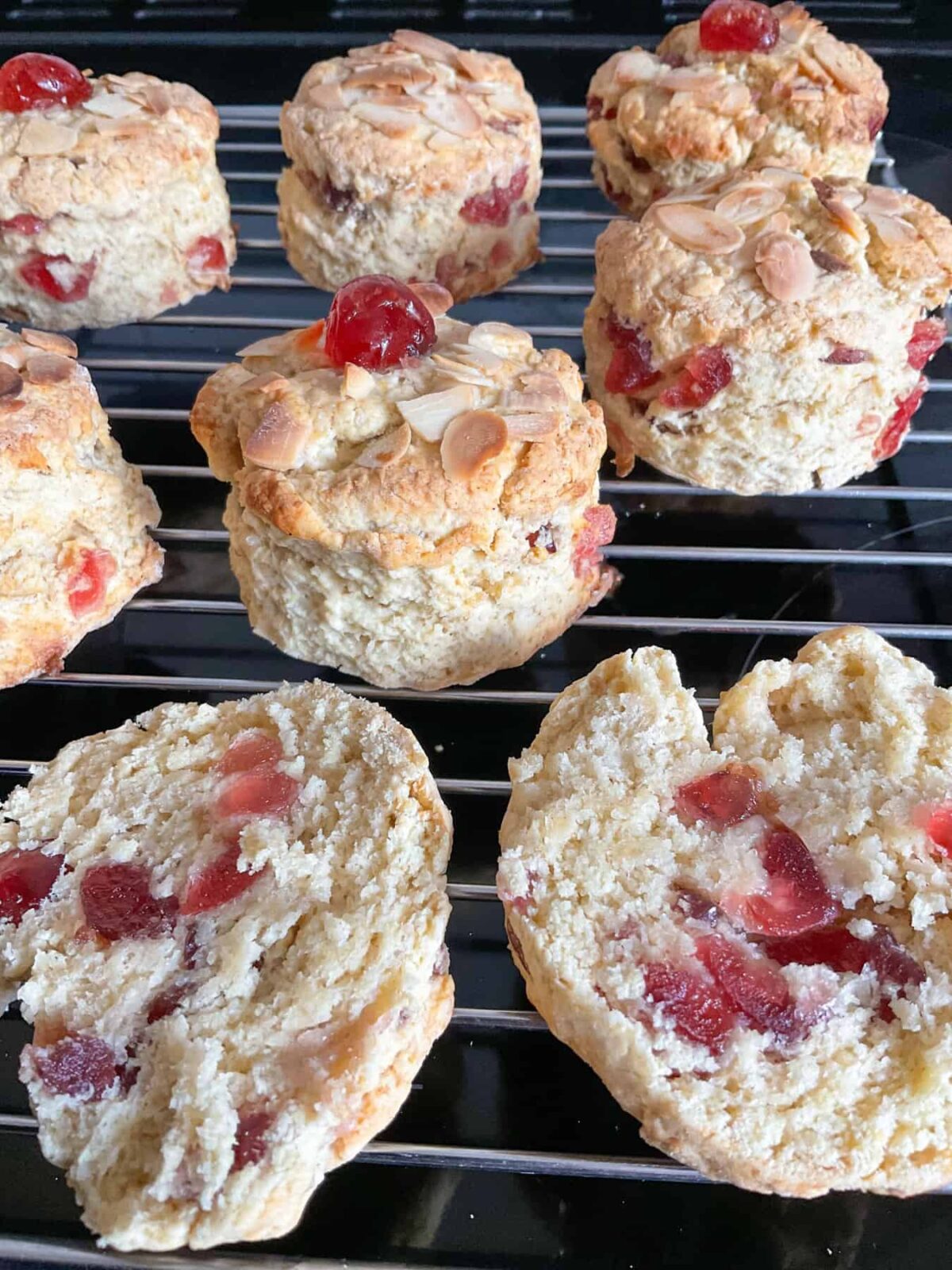
More traditional afternoon tea recipes made without eggs or dairy
Planning a vegan afternoon tea? An afternoon tea can be an extra special affair with a selection of sandwiches, baking, and scones, or it can be as simple as a pot of tea and a piece of whatever you've just baked today.
***please note: for US measurements click the 'US customary button' within the recipe and the measurements will switch to tablespoons, cups, and ounces.***
📖 Recipe

Old-Fashioned Cherry Scones
Equipment
- sieve
- Mixing bowl
- cutlery knife or similar
- biscuit or cookie cutter about 2 ½ inch [2-3cm] diameter
- Baking tray with parchment paper
- cooling rack
Ingredients
- 285 grams self-raising flour [or self-rising flour]
- 2 teaspoons baking powder
- 2 tablespoons granulated sugar [or caster sugar] for sweeter scones an extra tablespoon of sugar can be added
- 60 grams margarine [or plant-based butter or your usual baking fat, such as Stork]
- 120 grams glacé cherries [candied cherries]
- 240 millilitres plant-based milk [use your preferred milk, soya or oat are good choices]
- 1 teaspoon vanilla essence [or extract, can replace with almond]
Instructions
- Preheat the oven to 200 Fan, 220C, 428 Fahrenheit, Gas 7.
- Sift the flour and baking powder into a mixing bowl, and stir through the sugar.285 grams self-raising flour, 2 teaspoons baking powder, 2 tablespoons granulated sugar
- Add the margarine or butter in small blobs to the mixing bowl, and using your finger tips rub the margarine into the dry mixture until it resembles bread crumbs.60 grams margarine
- Chop the glacé cherries into halves and quarters, they will be sticky but that's fine.120 grams glacé cherries
- Stir the cherries through the dry mixture so that they are evenly distributed and coated in flour mixture.
- Pour in 4 tablespoons of the milk along with the vanilla and stir well with a cutlery knife. Add 2 more tablespoons and stir again. It usually takes about 8 tablespoons to bring the mixture together into a dough that is not sticky. But the exact amount of milk required may vary.240 millilitres plant-based milk, 1 teaspoon vanilla essence
- The mixture will start to look scraggly and this means that it has had nearly enough liquid to bring it to a dough. Press the bits of dough together with your hands to form a dough. If its too dry then add more drops of milk and keep forming the scone dough ball.
- If the dough is too wet, dust some flour over your hands and your work surface, and place the dough onto the floured surface and gently knead some extra flour in, until the scone dough is drier.
- Pat the scone dough down with your hands until its about ¾-1 inch [2-2 ½ cm] high.
- Dust the biscuit cutter with some flour and cut out a scone shape, be careful not to twist the cutter but just shuffle it up and down to remove the scone from the rest of the dough.You may need to lift the scone up inside the cutter and gently tap it out of the cutter.
- Place each scone onto a baking sheet.
- You'll likely need to push back the scone dough into a ball again, and then pat down, after cutting out a few scones.
- Once 6 scones are on the baking tray, you may have an extra smaller piece of dough which can be formed by hand into a rustic scone about the same height as the rest. This can be the bakers tester scone! However, you may not have any leftover dough!
- Brush each of the scones surface with some of the leftover milk, taking care not to let the milk drip down the scone sides.
- Bake on the middle oven shelf for 13-14 minutes. [We used an electric oven and the scones are perfect after 14 minutes at 220C]Check fan ovens a minute or so before as these type of ovens tend to cook faster than other types.
- Leave on the baking tray for a few minutes before removing to a wire rack to cool. Or enjoy warm.
Notes
- Nutritional data is for guidance only as its not an exact calculation as ingredients vary.
- Scones are at their best 1-2 days after baking.
- Keep scones within a covered container for 3-4 days.
- Scones older that 1-2 days can be refreshed by placing in a warm oven for a few minutes until warmed through.
- Or slice the scone in half and toast each side, and then spread with your favourite condiment.
- The glacé cherries do not need to be washed before using as the sticky residue will be dried up once incorporated through the flour mixture.
- We used Stork baking margarine and oat milk.
- For the vegan cream in the photos, we used Elmlea Plant Double Alternative Cream which whips up very easily in minutes.
- We also used Co-Op strawberry jam to fill the scones.
- For lots of useful tips on how to check if your scones have finished baking, how to avoid wonky scones, how to prepare the best scones, how to whip vegan cream, etc, then have a look at our recipe notes and FAQ section above.
- Although, don't get too caught up with trying to perfect the perfect rising scone as wonky scones are just as nice if not better! Our local bakery on the Scottish island always has wonky scones for sale and the tourists and locals love them!
- To prepare Cherry Bakewell Scones:
- Switch the vanilla out for almond essence or extract, and if liked top the scones with a few flaked almonds and half a cherry, add the topping after you have brushed the milk over the scone tops. Bake as normal.
Nutrition
Prepared our Tasty Teatime Old-Fashioned Cherry Scones? Do let us know how you get on with the recipe as we love hearing from you. Thanks so much, Jacq x


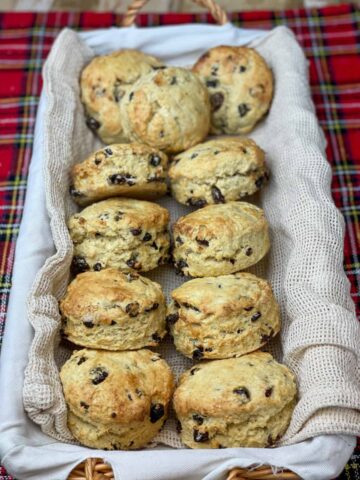
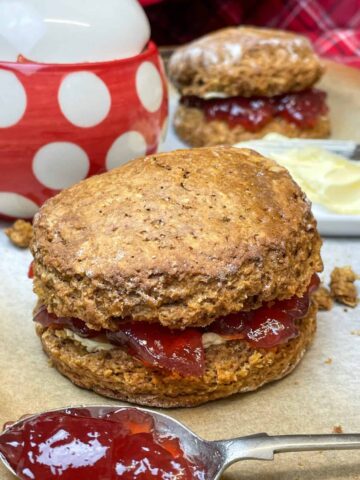
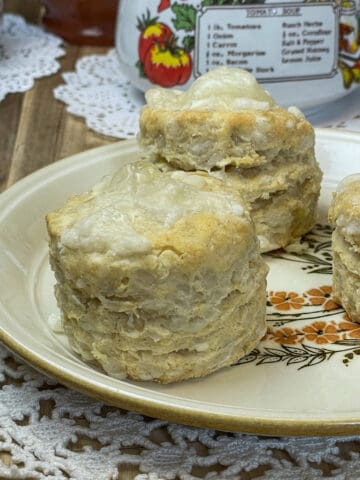
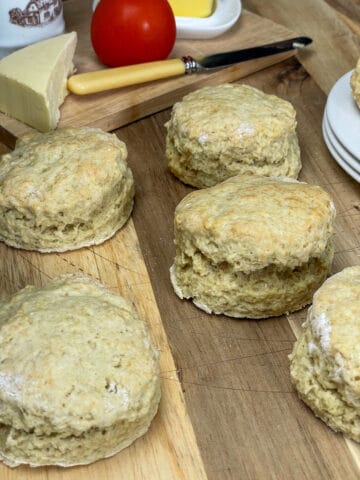
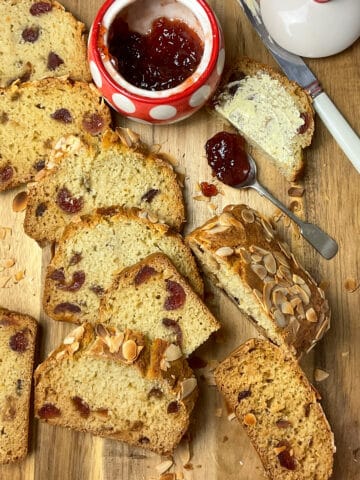
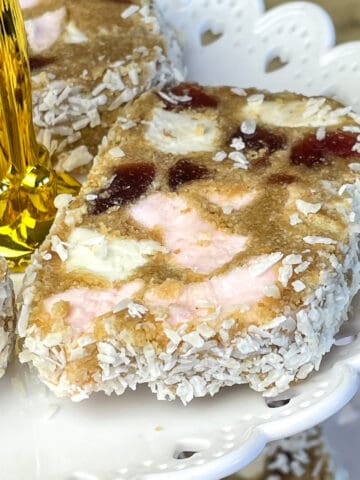
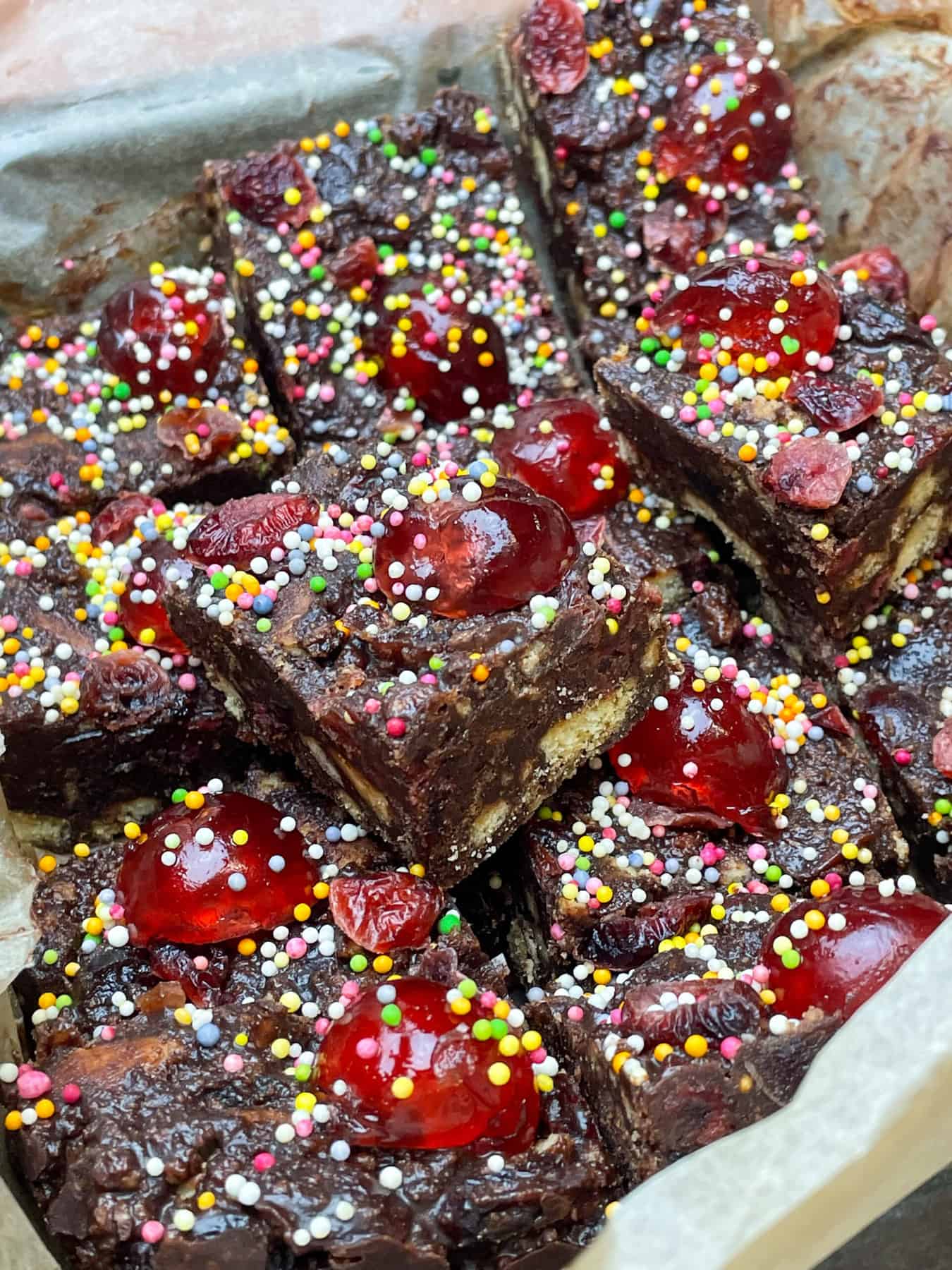
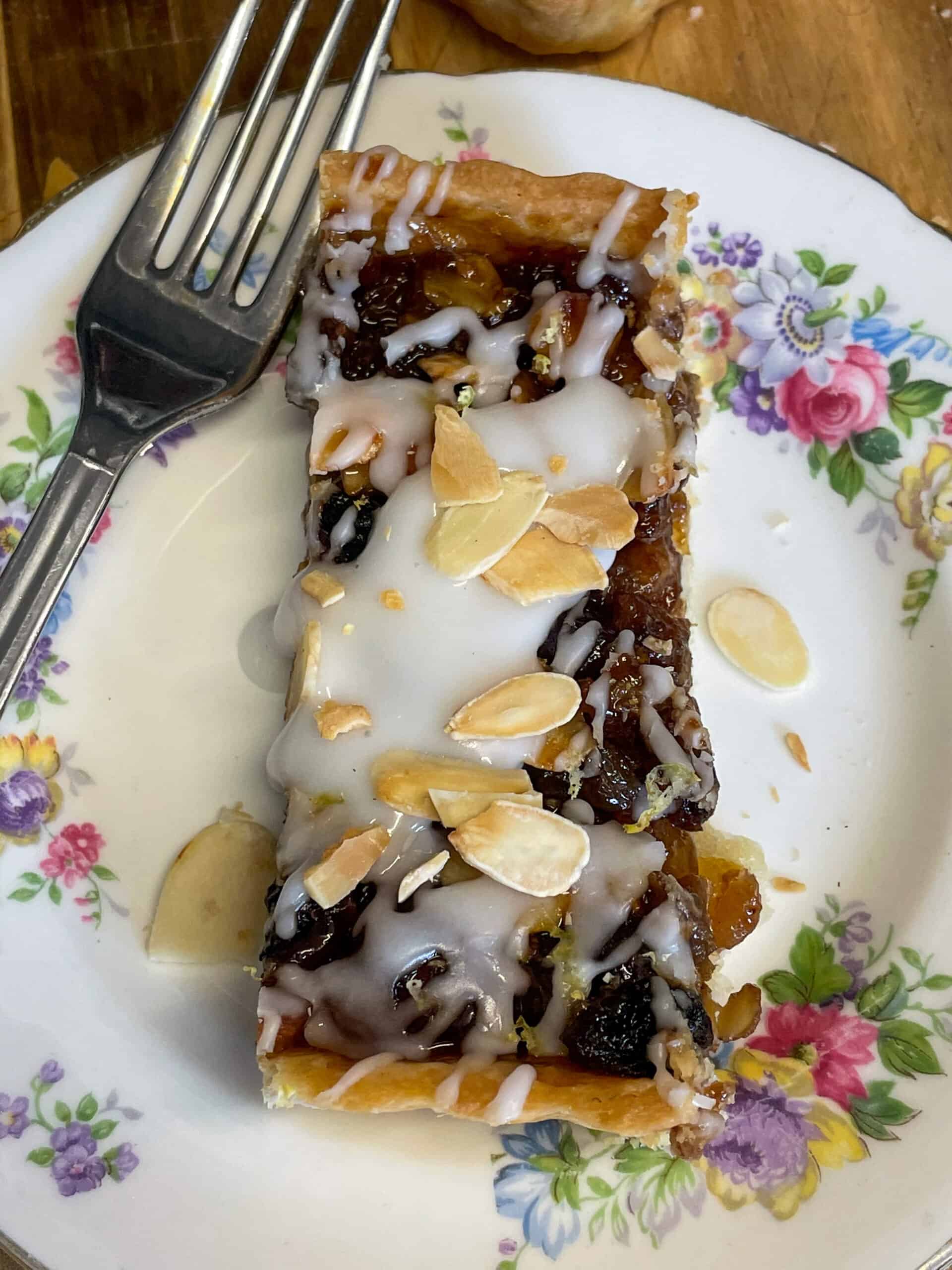
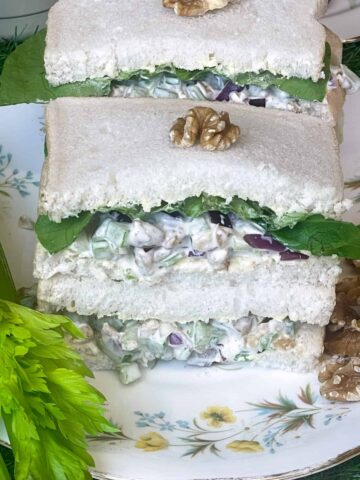
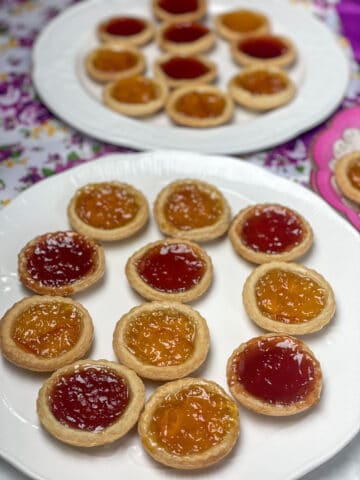
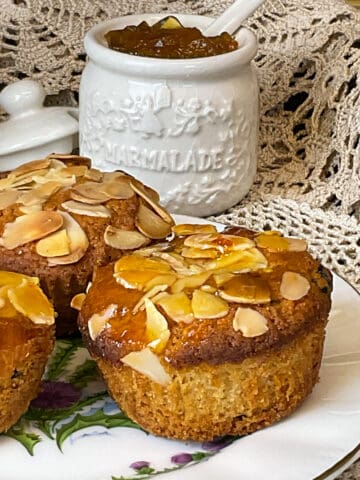
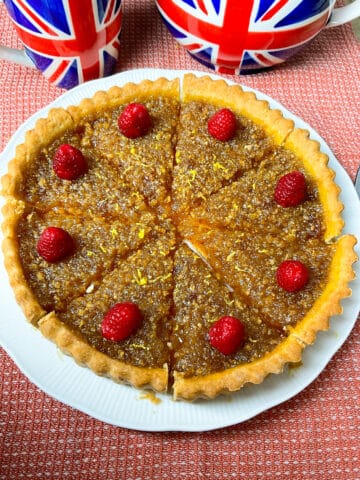
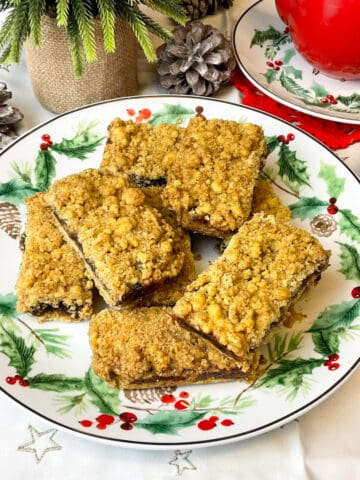
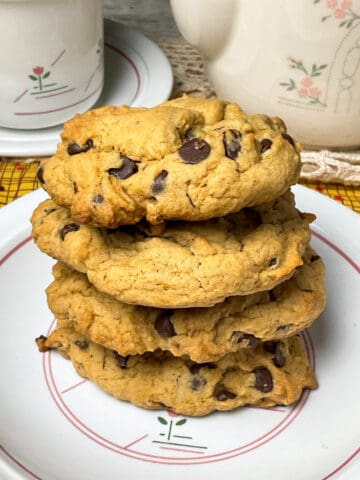
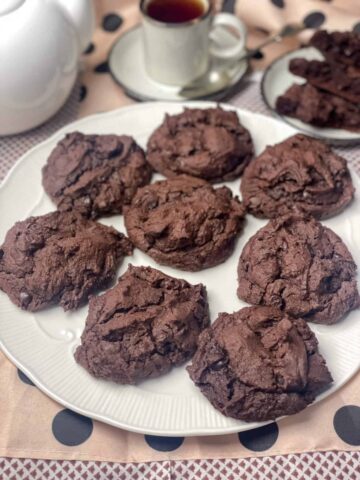
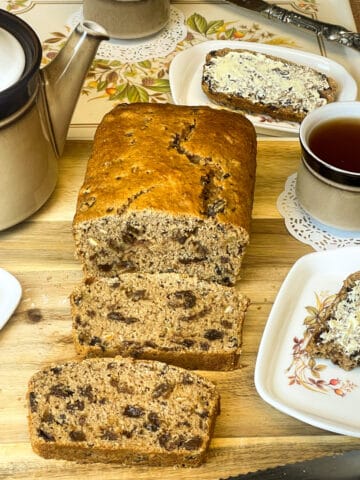
Jazz
hi. what are the measurements for the ingrdients?
Jacq
Hi, The measurements are in the recipe card, here is a direct link to the recipe card https://traditionalplantbasedcooking.com/old-fashioned-cherry-scones/#recipe If you click the 'jump to recipe' button at the very top of the blog post it will take you direct to the recipe. Jacq x